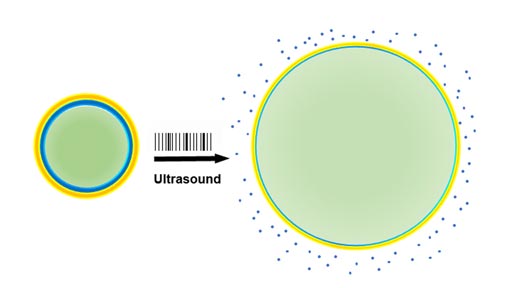New Technology Enables Precise Drug Delivery to Brain Using Ultrasound
By MedImaging International staff writers
Posted on 08 Feb 2017
Researchers have demonstrated that they can use ultrasound pulses to activate the release of drugs from nanoparticles in the brain of laboratory animals.Posted on 08 Feb 2017
The researchers released the concentrated drug doses temporarily in specific localized regions of the brain from inside minute biodegradable "nanoparticles" by means of precisely targeted ultrasound waves.

Image: The new technology uses non-invasive ultrasound waves to deliver drug-laden nano-particles (left) with a liquid center (green) that turns to gas and releases the therapeutic drug (blue) (Photo courtesy of Raag Airan).
According to the researchers from the Johns Hopkins University School of Medicine, the method could be used to deliver most psychoactive and other drugs, and advance therapies and research studies for the brain and other organs. The research results were published in on January 23, 2017, in the journal Nano Letters.
The new method could reduce the side effects of drugs considerable, because of the way it releases a much lower but concentrated dose a drug in a specific region. This results in a much lower overall drug doses for the patient during therapy treatment. The technology uses biomaterials, drugs approved by the US FDA, and ultrasound methods that have been tested, and found to be safe for humans. The researchers hope to start the regulatory approval process of their new technology for clinical applications within one or two years.
Associate professor of biomedical engineering, Jordan Green, PhD, said, "If further testing of our combination method works in humans, it will not only give us a way to direct medications to specific areas of the brain, but will also let us learn a lot more about the function of each brain area."








 Guided Devices.jpg)





